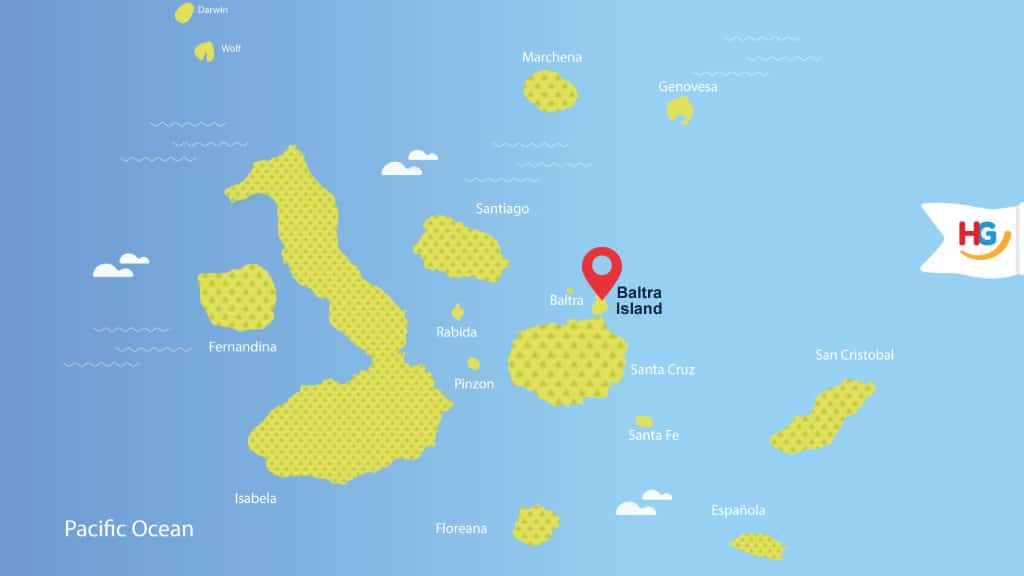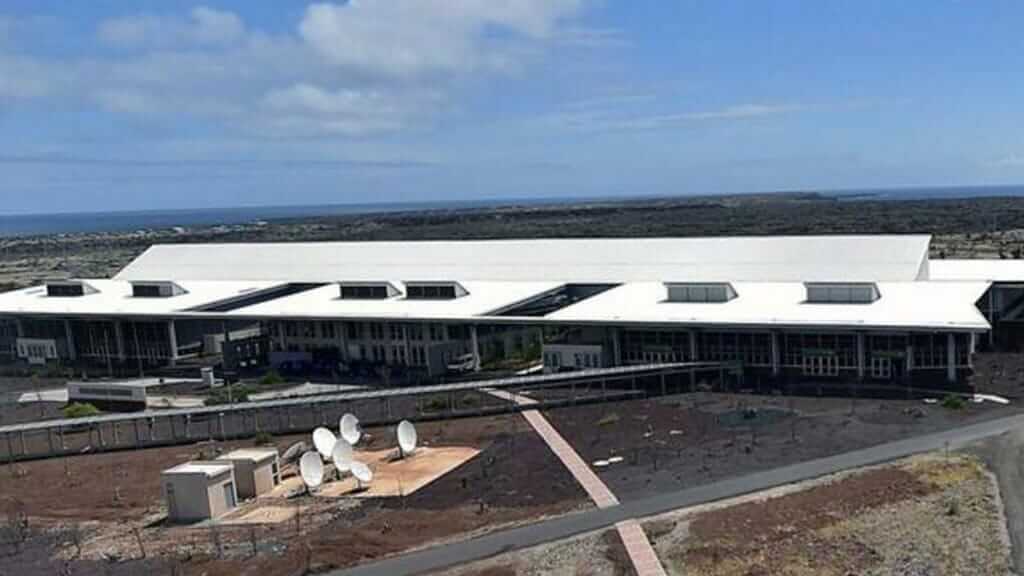Baltra Island
If you visit Galapagos then chances are your first steps will be taken on Baltra island. Centrally located, Baltra is the main hub and airport gateway for Galapagos vacations and adventures. From here it’s just a short skip across to Santa Cruz island and vibrant Puerto Ayora town. Although Baltra island doesn’t have any visitor sites or hotels, it is still a place with an interesting history. Above all though Baltra is a place of happy faces – the excitement of visitors arriving, and the blown-away satisfaction of those ending their trips.
Read on for everything you need to know about Baltra Island. How to get to Baltra? How to transfer over to Puerto Ayora? Why did the US have a military base here? How was Baltra airport the first ecological airport in the world?
SECURE YOUR GALAPAGOS TRAVEL
Get a FREE personalised quote todayWhere is Baltra Island?
Baltra is located in the central area of the Galapagos archipelago, to the north of Santa Cruz island.
How to get to Baltra Island?
Daily flights depart from Guayaquil and Quito to Baltra airport. At time of writing there are 2 airlines with Galapagos flight schedules: Avianca and Latam.
Flights to Galapagos do have special controls in place to protect the islands from invasive species and control migration. Check out our How to get to Galapagos blog post for tips to guide you through these processes.
If you are joining a cruise or land tour then your naturalist guide will be waiting with a sign in airport arrivals. While visitors traveling under their own steam need to take a bus & ferry combo to reach Puerto Ayora town on the opposite coast of Santa Cruz island.
How to get from Baltra to Puerto Ayora?
If you are making your own way from Baltra to Puerto Ayora, just follow these easy steps.
The first challenge is to take the short “Lobito” bus ride to the Itabaca Channel. Buses pick up passengers right outside the airport, and charge a $5 fee for the journey. Take care to board the right bus because there are two routes – to Itabaca (the correct bus), and to the dock to board cruise ships.
The 150m wide Itabaca Channel separates the islands of Baltra and Santa Cruz. A regular ferry service transports visitors from one side to the other. First load your bag onto the roof, then jump aboard and take a seat. The US$1 fee is charged during the short crossing.
For many visitors this will be the first encounter with some exciting Galapagos wildlife. Galapagos sealions laze on the benches at the dock, and swim playfully around the ferry. Frigates, Pelicans and Blue-footed boobies glide overhead. A keen eye might even spot baby Hammerhead sharks exploring the sea close to their nursery.
Disembarking on the other side of the channel you have reached Santa Cruz island. White pickup truck taxis are the quickest route to Puerto Ayora, charging aproximately $20 for the 45 minute journey. The public bus is a slower and cheaper alternative. The journey is very scenic, heading over the lush green highlands, before descending to Puerto Ayora town.
There are no Baltra island hotels, so book accommodation at Puerto Ayora if you plan to stay the night.
GET FREE ADVICE
From a Galapagos destination expert todaySeymour Airport on Baltra Island
Baltra airport name: Seymour Airport.
Baltra airport code: GPS.
Baltra Airport is known locally as Seymour Airport, derived from the original name of this island (South Seymour).
Seymour Airport does have one very impressive claim to fame – it is the world’s very first ecological airport! In 2013 the airport was completely remodelled using an innovative design to reduce energy consumption from lighting and ventilation, re-use rainwater and adopt recycling of waste. Services at Baltra Airport include a diverse range of shops to buy last minute souvenirs, and an open area serving food and refreshments.
About Baltra Island
English Name: South Seymour.
Ecuadorian Name: Baltra.
Total Area: 8 sq miles.
Population: zero (uninhabited).
Baltra’s original name (South Seymour) was in honour of Lord Hugh Seymour, a distinguished British Royal Navy officer from the 18th century. It was later renamed to Baltra island, but remarkably there is no record of the reason or significance of the name Baltra.
Geology of Baltra Galapagos
Baltra looks rather different from other islands at Galapagos in that it is very flat, with no volcanic peak. Baltra island was created by geological uplift rather than direct volcanic activity. It was in fact the volcanic formation of nearby Santa Cruz island that altered the underwater geology, causing the small island of Baltra to rise up above the ocean.
On your short bus ride from Baltra airport to the dock keep your eyes open for pillow lava. These are rounded volcanic rocks that form underwater, now in the process of plant colonisation.
Baltra Island Habitat & Wildlife
The habitat of Baltra island is very typical to that of the lowland areas on other Galapagos islands. Baltra is very arid with low scrub, Opuntia cactus plants and Palo Santo trees.
One creature that loves this arid ecosystem is the Galapagos land iguana. They often hang out underneath large cactus plants, waiting for their favorite food of prickly pear or cactus pads to fall off. The fact that we find land iguanas on Baltra island today is in itself a curious story. Back in the 1930s a small group of Baltra land iguanas was removed to nearby North Seymour island where the land iguana population was struggling. Some years later in 1954 the Baltra iguana in turn became extinct. The fact that Baltra iguanas were now thriving on North Seymour meant that it was possible to repopulate the Baltra population again. Today there are over 400 land iguanas roaming Baltra island, sometimes they can be spotted close to the airport runway.
Another Galapagos creature that visitors are guaranteed to encounter at the airport is the famous Darwin Galapagos Finch. These cheeky fellas are rather tame, and more than happy to eat food crumbs from the floor (or tables) of the airport restaurant.
Baltra History
Baltra island has played an important role in the development of the Galapagos islands. Back in World War II the US Air Force established a strategic base here, to protect the Pacific Ocean and Panama Canal from enemy attack. The first air strip in Galapagos was built here, as well as infrastructure that included a bowling alley and movie theatre.
When the war ended in 1945 the US forces withdrew, handing Baltra air base over to the Ecuadorian government. This was a key moment in the transformation of Galapagos into the popular tourist destination we see today. Flights from the mainland now had a long access runway, and it wasn’t long before a passenger airport and roads were developed to open the islands up to tourism.
The #1 Trusted
Galapagos Travel Agency
Contact us for a FREE GALAPAGOS TOUR QUOTE, or for more information to plan your Galapagos vacation with help from the experts.
In conclusion, the only real excitement of Baltra island is that you are taking your first steps at Galapagos here. It’s a place to arrive at, and move quickly onto bigger and better things. But don’t be complacent, the onward journey to Santa Cruz is scenic, and there may well be fun wildlife encounters on route. Also keep an eye out for the ruins of US Air Force history, and enjoy the uniqueness of Seymour Airport.




